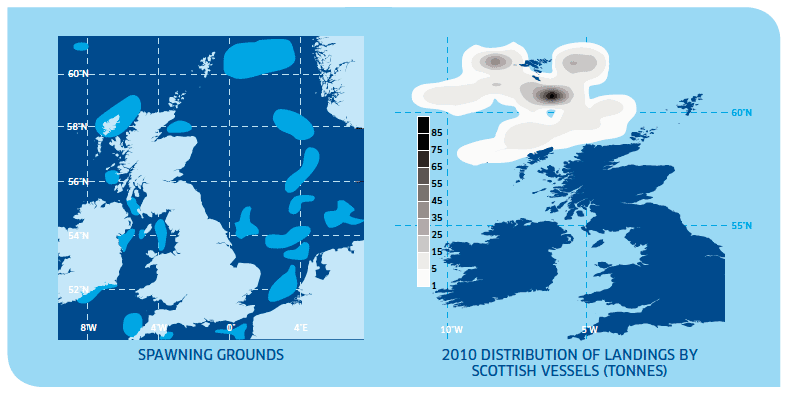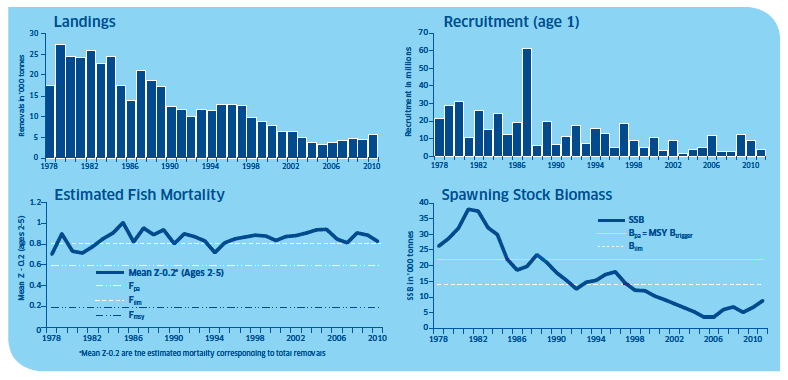Fish and Shellfish Stocks 2012
Fish and Shellfish Stocks 2012. State of Scottish fish stocks, TACs and biology of the stocks for 2012.
COD STOCKS — WEST OF SCOTLAND
West of Scotland cod ( Gadus morhua) is mainly taken in a mixed demersal fishery by bottom trawl gears with mesh size 100 mm and greater and is now regarded as a by-catch species. Discarding remaind high for this species, approximately 83% caught in 2010 was discarded.
2012 position : UK share zero tonnes
Last Year : 110 tonnes
Landed into Scotland in 2010 : 114 tonnes
Value for 2010 : £225,000
Biology
Cod are distributed throughout the west coast but occur mainly in the northern area. Tagging experiments have shown that cod from this region inter-mix with those in IVa, west of Shetland. In contrast, further south in areas such as the Clyde, cod appear to be largely resident all year round.
Many cod reach maturity by two years old and by the time they reach four years, all cod are mature. An average three year old female can produce around four million eggs in a season. Spawning on the west coast takes place between January and April with a peak in March and occurs in most offshore areas. The major spawning area extends offshore from the Outer Hebrides although there are other important areas such as the Clyde. During the spawning season, there is a continuous distribution of cod eggs and larvae around the west and north coasts of Scotland. It is possible that these drifting eggs and larvae could contribute in some small way to the North Sea stocks. Although cod can live for many years, they are big enough to be caught as early as age one. By the time they reach two years old, young cod are fully exploited by the commercial fishery. Many fish are therefore caught before they have the chance to spawn and less than one twentieth of fish aged one will survive to the age of four. This means the stock is particularly vulnerable to an on-going reduction of the spawning component.
Young cod produced in springtime live in the upper water layers until about July before adopting the demersal way of life. They grow quickly and can reach 20cm after one year, 50cm after two years and 80cm by the time they are four years old. On the west coast, juvenile cod during the first year of life are often found close inshore or around the entrances to sea lochs. As they grow older they move offshore, although they appear to recruit to nearby adult areas.
Cod are active feeders and around three quarters of the food of all cod consists of fish and crustaceans. Unusual food items are sometimes eaten: small birds, stones, coal and the occasional salmon smolt.

ICES ADVICE ON MANAGEMENT
Information Source: ICES advice 2011 ( http://www.ices.dk/committe/acom/comwork/report/2011/2011/cod-scow.pdf). Quoted text in italics.

MSY and precautionary approach reference points
| Type |
Value |
|
|---|---|---|
| MSY Approach |
MSY B trigger |
22,000 t |
| F msy |
0.19 |
|
| Precautionary Approach |
B lim |
14,000 t |
| B pa |
22,000 t |
|
| F lim |
0.8 |
|
| F pa |
0.6 |
State of stock and advice
- Total mortality ( Z) in 2010 was estimated to be high (1.024) and cannot be accurately partitioned into fishing mortality ( F) and natural mortality ( M).
- Spawning stock biomass for 2011 was estimated to be just over 8,700 tonnes.
- Fishing mortality cannot be determined in relation to any of the reference points. The stock biomass is well below both the Precautionary approach reference limit ( B lim) and the level set for achieving maximum sustainable yield ( MSY B trigger).
- Due to the decline of the spawning stock biomass to very low levels only a zero catch of cod would be compatible with the precautionary approach.
- Fishing advice following the MSY approach calls for catches (mainly discards) to be reduced to the lowest possible level.
The stock is suffering impaired recruitment. SSB is very low. It is necessary to reduce all sources of fishing mortality to recover the stock above Bpa as quickly as possible. Management measures taken thus far have not recovered the stock. The 2008 year class is estimated to be more abundant and consequently additional measures (such as real-time closures) to protect it are essential to ensure that it contributes to the rebuilding of the stock.
Following the management plan would give a TAC of less than 137 tonnes in 2012. This could be made lower at the Council's discretion if advised that the stock is failing to recover properly. As it is not possible to assess unaccounted mortality accurately, ICES cannot yet evaluate if the management plan is in accordance with the precautionary approach.
Given the low SSB and low recruitments in recent years, it is not possible to identify any non-zero catch which would be compatible with the precautionary approach. Bycatches, including discards of cod in all fisheries in Division VIa, should be reduced to the lowest possible level.
Management outcomes for 2012
At the December 2011 meeting in Brussels, the Council of Ministers decided that the international Total Allowable Catch for west of Scotland cod should be zero Tonnes with a consequent UK quota for 2012 of zero tonnes. A 1.5% bycatch allowance has however been introduced for EU fleets fishing this stock.
This quota decision was reached in response to the recommendation that only catches reduced to the lowest possible levels are compatible with the MSY and precautionary approaches and in light of difficulties in separating fishing mortality from natural mortality.
The UK interpretation of permissible effort 'buy back' under the Conservation Credits Scheme (effort levels can be reinstated up to the level of the baseline established at the start of the scheme) was upheld. In accordance with the cod LTMP a 25% cut in effort (before buy back) from the level in 2011 was enforced. To justify existing and future effort buy back, the UK is committed to the introduction of highly selective gears in both finfish and Nephrops targeted fleets. For the West of Scotland the UK also committed to introducing spatial measures to separate catches of cod and other gadoids from 1st January 2012.
Contact
There is a problem
Thanks for your feedback